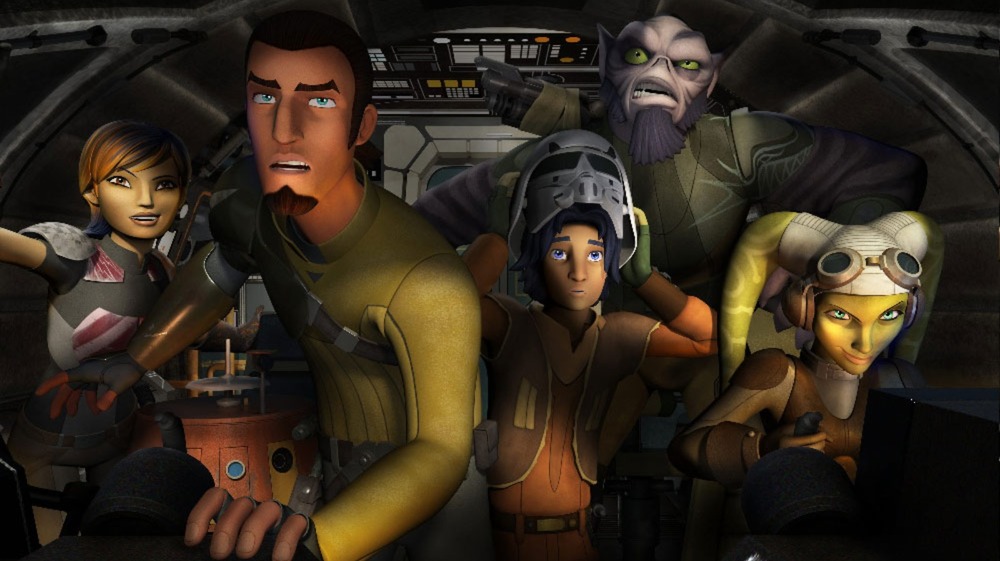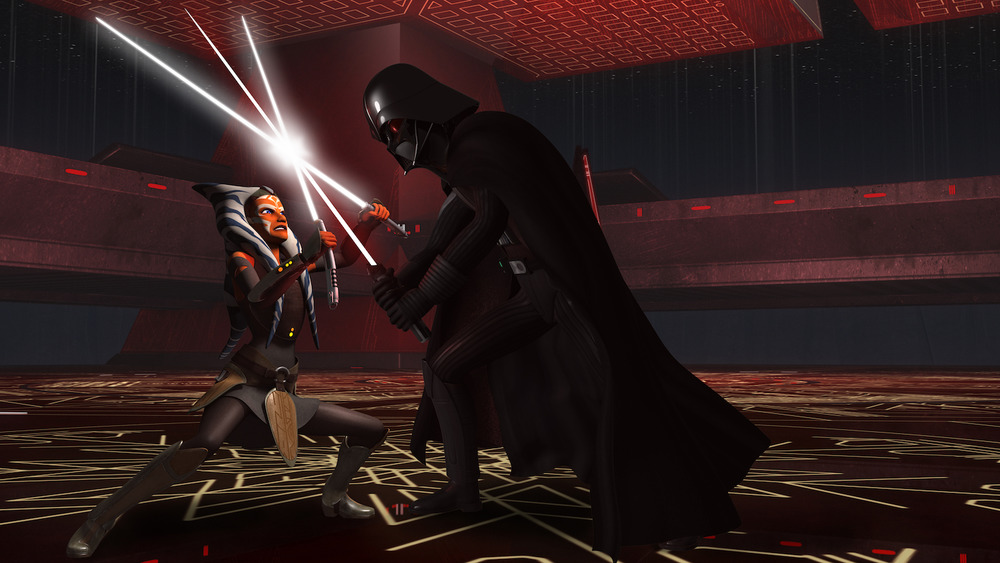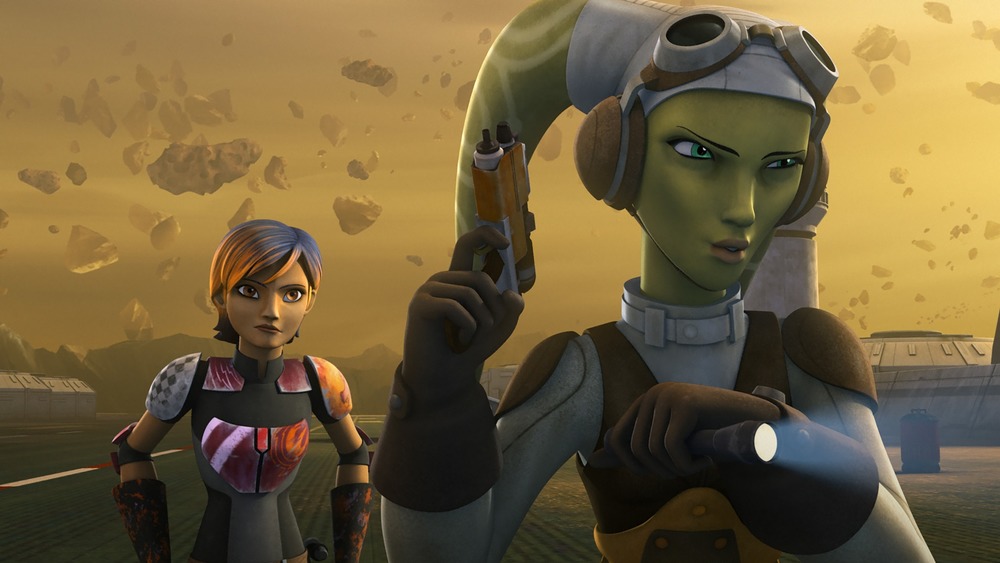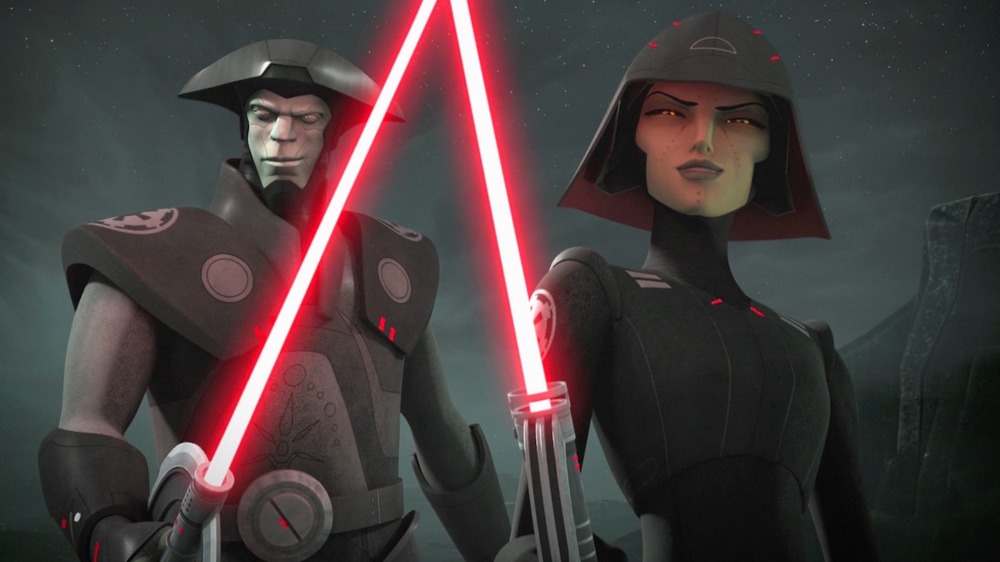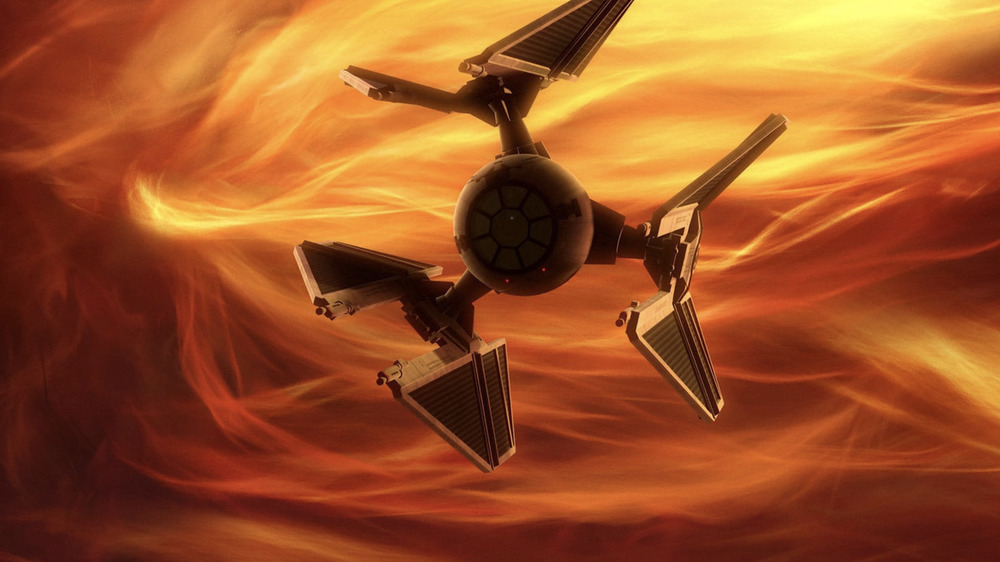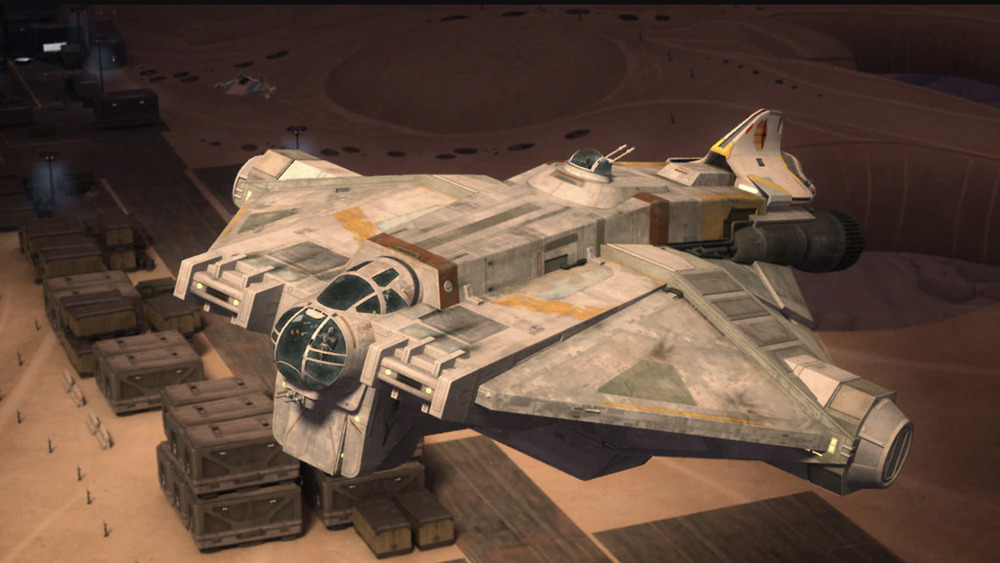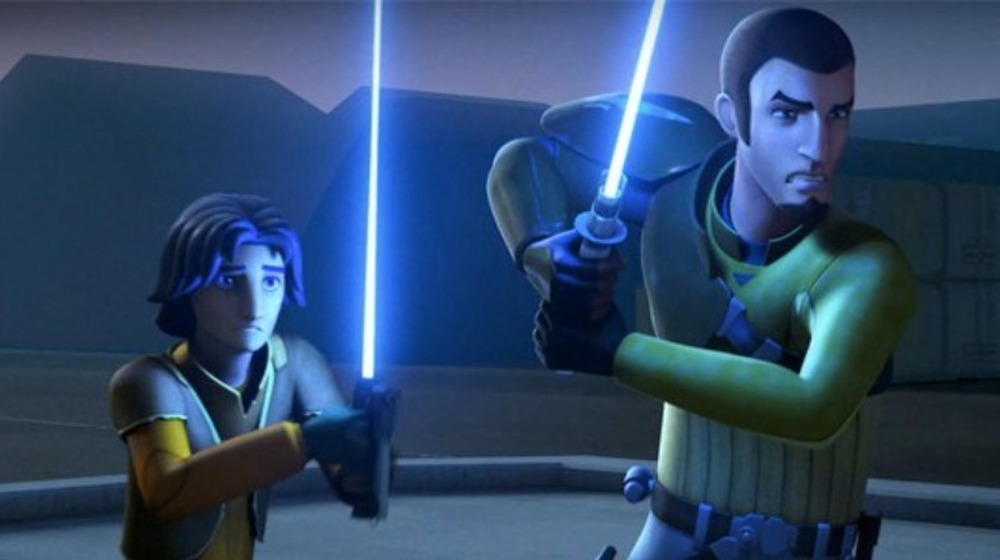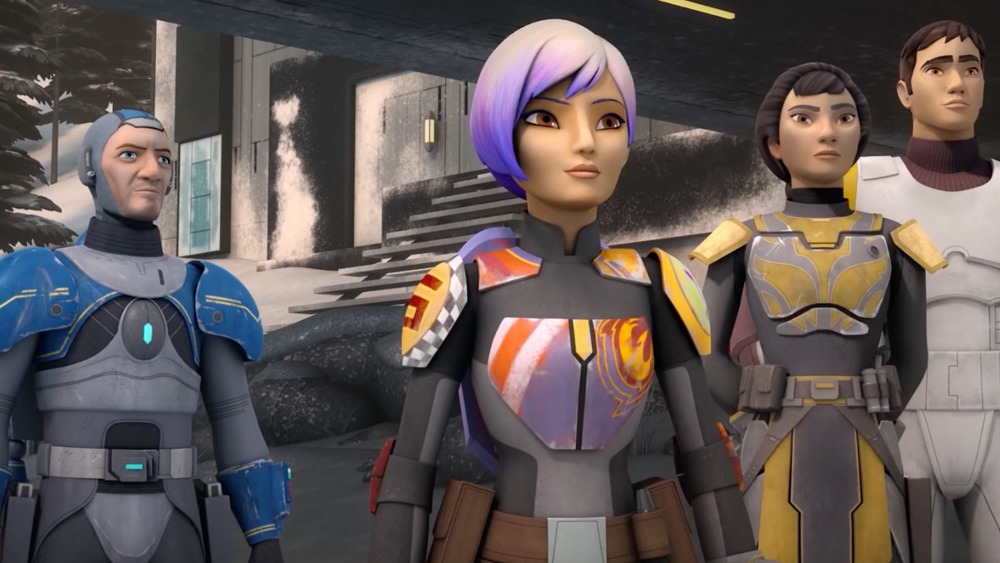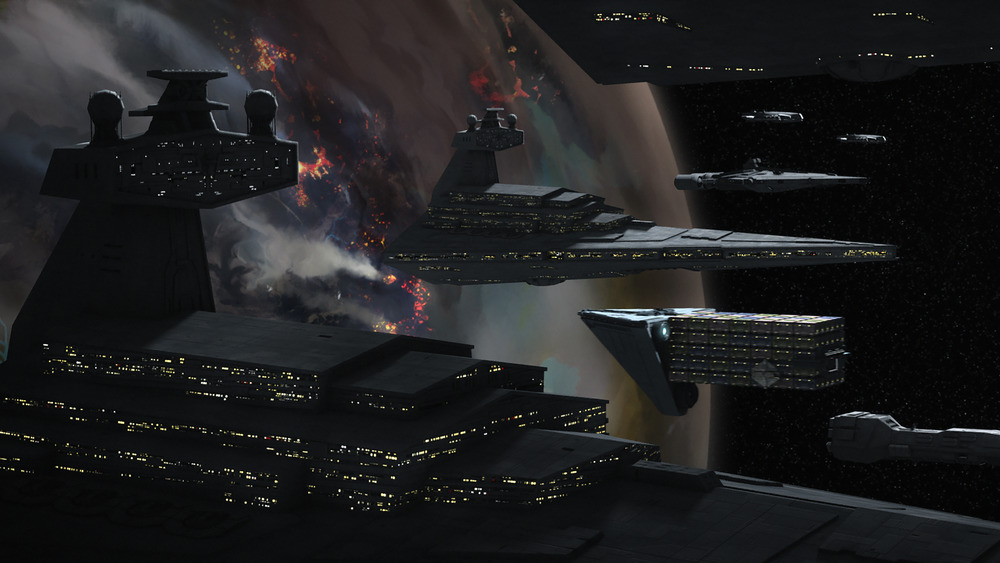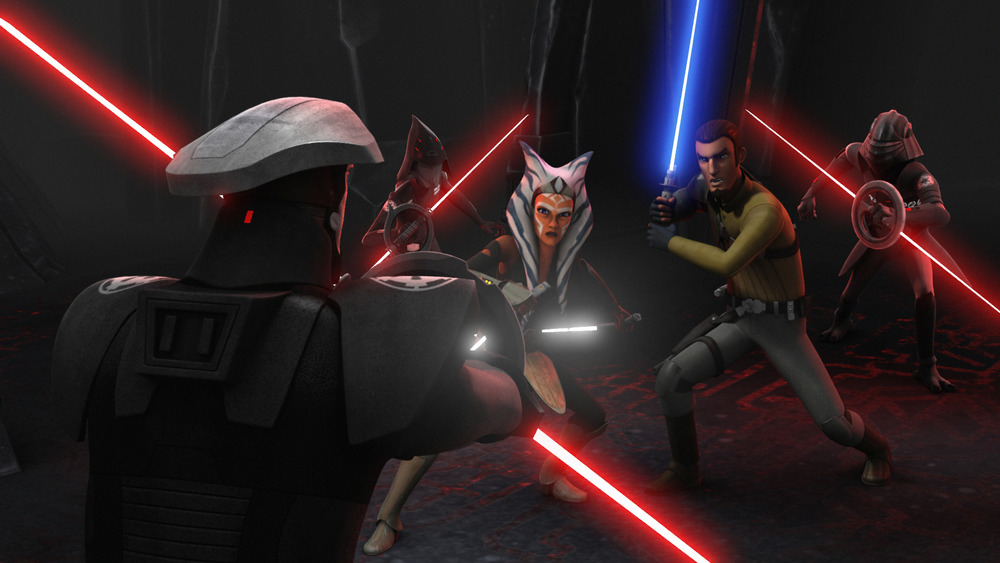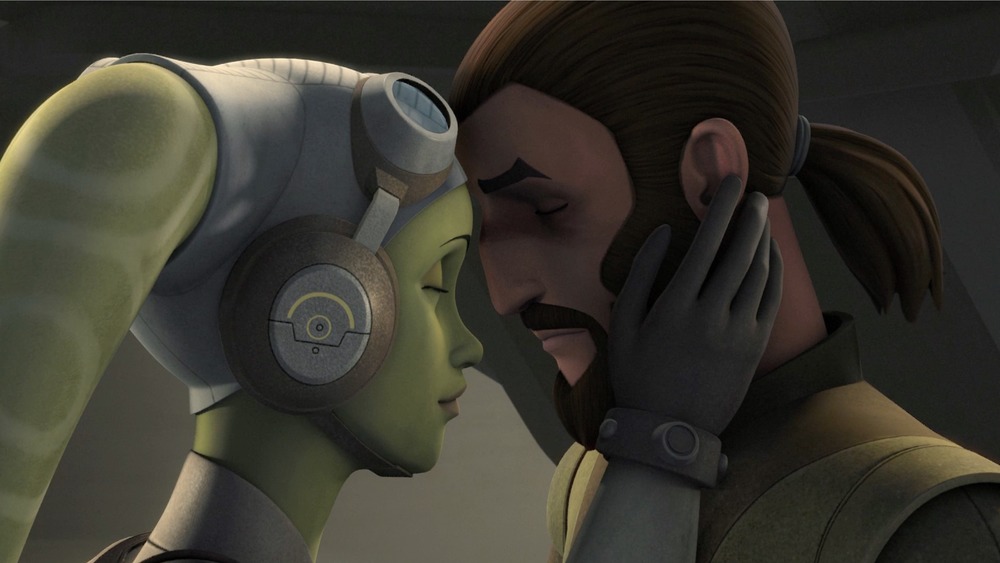Why Rebels Is The Best Star Wars Series
It has become a rite of passage for Star Wars fans and critics to reassess the canon at the advent of every new production. Where does a new show or movie rank within the hierarchy? Which film's reputation has been rehabilitated, and which doesn't hold up so well? Now that The Mandalorian is well into its second season, the shape of its overall Star Wars-iness rounding into view, enthusiasts can begin a new assessment about what belongs at the top.
Recent episodes of The Mandalorian have been chock-full of the usual Star Wars elements — X-Wing fighters and Stormtroopers, Mon Calamari and Tusken Raiders. But they have also featured very specific elements from various Star Wars animated series, including Rebels, which ran for four seasons from 2014 to 2018 and remains a huge fan favorite. The Mandalorian leader Bo-Katan, Anakin Skywalker's padawan Ahsoka Tano, and even the giant Krykna Spiders that menaced Ezra Bridger and company at their base on Atollon have all made appearances. This isn't surprising, given that Dave Filioni, the creative vision behind Rebels, is also an executive producer and director on The Mandalorian. And of course every version of Star Wars references some other version. But perhaps Filoni is also drawing on his own show as a way of suggesting what we argue here: that Rebels is not only the best Star Wars show but one of the best expressions of Star Wars so far.
Rebels perfectly bridges the prequels and the original trilogy
In the Star Wars timeline, Rebels is situated about 15 years after the end of the Clone Wars and several years before the events of A New Hope. The show chronicles the period when the Galactic Empire was at the height of its power and the fledgling Rebel Alliance was tentatively coming together from far-flung corners of the galaxy. As such, the series creators were able to populate the show with characters and situations from the prequel trilogy, The Clone Wars animated series, the original trilogy, and Rogue One. The series even looks past the original trilogy in its final episode.
Rebels lives in the aftermath of the Clone Wars and dramatizes their fallout — how the Jedi were all but extinguished and how Darth Vader and his Inquisitors hunted down the few remaining Jedi, like Kanan and Ahsoka Tano. This allows the show to have the best of all worlds (literally), picking and choosing from fan favorites and the more compelling Star Wars elements. In addition to Vader and Ahsoka, these include Obi-Wan, Yoda, Commanders Rex and Cody, Darth Maul, Bail Organa, Bo-Katan Kryze, Emperor Palpatine, and others from the prequels and The Clone Wars. Mon Mothma and Saw Gerrera show up from Rogue One. And original trilogy characters include Princess Leia, Lando Calrissian, Wedge, and even a blink-and-you'll-miss-it Luke Skywalker cameo. Rebels' ability to draw on material from throughout the saga helps account for the richness of its storytelling.
Rebels has the most intriguing female characters
The original trilogy gave the world an indelible heroine in Princess Leia Organa, though many have pointed out that the female presence in the first three movies is otherwise negligible. Two decades later, the prequels arguably regressed, featuring only one female character of note — Padme Amidala — who is mostly relegated to the sidelines and who succumbs to one of the most inexplicable deaths in movie history. The sequels feature diversifying representation, particularly The Last Jedi. Despite criticism of the later trilogy, most fans praise Rey as an excellent lead.
But Rebels is the high water mark for both the movies and the TV shows. Hera Syndulla and Sabine Wren are complex, independent, fierce, funny, skilled female warriors who exist far beyond their connection to the male characters (Hera and the Jedi Kanan Jarrus are in a relationship, but it is rarely mentioned). Beyond the two leads, the show populates an entire female universe, including villains such as the malevolent Seventh Sister Inquisitor and the ruthless Imperial Governor Pryce. The show also centers a number of episodes on Sabine's fellow Mandalorian women — her mother and sister, the bounty hunter Ketsu Onyo, and the Mandalorian leader Bo-Katan. And there are crossover appearances from other Star Wars series. The popular Jedi Ahsoka Tano continues her role from The Clone Wars, while Mon Mothma of Rogue One and Return of the Jedi returns as a rebel leader. Even young Princess Leia makes an appearance.
The villains are wicked cool
Star Wars villains tend to be the high points of the saga. Like Darth Maul in The Phantom Menace, they make strong impressions despite otherwise weak soup. Maul, General Grievous, Darth Vader, Boba Fett, Grand Moff Tarkin, Jabba the Hutt, and Emperor Palpatine are all memorable for being sinister, slimy, or both. In just four seasons, Rebels features many of these canonical villains plus a whole host of new malevolent meanies. Among them are Vader's Grand Inquisitor and his Jedi-hunting brethren, the fanatical Governor Price, the Imperial Navy Admiral Konstantine, and the treacherous Mandalorian Gar Saxon. New to canon (but not the Expanded Universe) is the blue-skinned Grand Admiral Thrawn, who becomes the show's main villain in season 3. Thrawn's cultured demeanor and soft voice conceal poisonous intent. He doesn't just want to destroy civilizations — he wants to appropriate their cultures for his private edification.
Of characters from other series, Darth Maul gets a memorable arc in Rebels, which culminates in his final vanquishing at the hands of Obi-Wan Kenobi. As Rogue One did, Rebels uses Darth Vader judiciously. The Dark Lord of the Sith doesn't dominate the series, but he appears at crucial moments, such as the season 2 conclusion when he confronts Ezra and then duels his Clone Wars padawan Ahsoka. This is a heartbreaking moment for fans who know how close Anakin and Ahsoka once were. Their epic lightsaber battle is just one of many thrilling moments featuring the show's villains.
Rebels has the most awesome ships
The spaceships are the glue that holds Star Wars together, whooshing heroes and villains across hyperspace and lighting up the empty expanses like a galactic Main Street Electrical Parade. The most prominent ship in Rebels is the popular Ghost, home to our main cast, along with its detachable Mini-Me, the Phantom. As the Ghost joins forces with the fledgling Rebel Alliance, the classic Rebel fighters show up — X-Wings, Y-Wings, A-Wings, Corellian corvettes, anything that ever sold a million Lego sets. There's even an entire episode devoted to the birth of the B-Wing from Return of the Jedi, with Hera taming the prototype like some kind of willful winged beast.
Rebels features the Imperial favorites as well, including the ubiquitous Imperial Star Destroyer and early versions of AT-AT and AT-ST walkers. But the show tops itself with its TIE fighter bounty. Everybody loves TIE fighters, which is why Star Wars has created so many versions over the years. Rebels features many of the classic TIEs from previous Star Wars entries, including the standard TIE, the Interceptor, the Bomber, and Darth Vader's specialized fighter. Rebels adds a couple of sublime new entries to the TIE fleet with the TIE Advanced Prototype — the wing-folding baddie piloted by the Inquisitors – and the yellow-winged Mining Guild TIE. The series also showcases the six-winged TIE Defender. Last but not least is Sabine's personally decorated TIE, decked out like something you'd find at a Berkley art walk.
Who wouldn't want to live on the Ghost?
Speaking of the Ghost, the snub-nosed Corellian freighter may not be the sleekest-looking ship in the Star Wars saga, but "she's got it where it counts, kid." That includes speed, maneuverability, and sensors to carry her stealthily past Imperial ships. But perhaps most importantly, the ship feels like a home. Part of the enduring appeal of Star Wars is that fans think of the characters as family (the good guys, anyway — fewer viewers probably imagine Vader and Palpatine vacationing together, although never underestimate the imagination of fan fictioneers). Even more so than the Millennium Falcon, the Ghost operates as a flying quarters, with cabins and a holochess-equipped dayroom.
Rebels was aimed at kids, especially in its first few seasons, and the series does a great job of making the Ghost feel like a perennial sleepaway camp in Star Wars playland. This is especially true given that the young Ezra Bridger is the point-of-view character early on. Life on the Ghost for him is the epitome of a young teen's fantasy. He's got a furry, roughhousing roommate in Zeb, a zippy robot, two caring but not overprotective parents in Hera and Kanan (who let him play with a lightsaber in the living room), and super-cool teen gal with fantastic hair living down the hall in Sabine. Okay, so maybe the fact that the Empire murdered Ezra's parents casts a bit of a pall over the arrangement. But still! Fun!
Rebels deepens Jedi and Force mythology
Each of the Star Wars trilogies feature Force- and Jedi-focused narratives, while the stand-alone entries, Rogue One and Solo, tell stories from mostly Jedi-free corners of the Star Wars universe. Having to focus on one or the other can be a limitation of a feature film, but a series — especially one that runs for 75 episodes as Rebels did — has the freedom to explore stories across the saga spectrum. The effect of this is narrative balance. The show can delve deeply into Jedi lore and then just cut away to Sabine paint-bombing something if things get too supernatural.
The lore in Rebels centers around Jedi Knight Kanan Jarrus, who adopts the Force-sensitive orphan Ezra Bridger and then takes it upon himself to train the boy. This is a somewhat treacherous undertaking because Kanan has never attained the rank of Jedi Master. For further guidance, the two make several pilgrimages to the Jedi Temple on Lothal, which sits above a natural wellspring of Force energy. Using the temple as a narrative conduit, the show dramatizes Dark Side showdowns and spiritual revelations for the Jedi heroes, as well as encounters with famous Jedi such as Yoda. It imagines new manifestations of Jedi mysticism as well, including ancient archaeological treasures, portals to astral planes, and giant Force-sensitive Loth-wolves. At times, the mystical menagerie verges on a psychedelic freak-out, but the deft storytelling keeps even the most out-there elements rooted in Star Wars mythology.
Mandalorians!
Do you love Mandalorians? Of course you do. Everybody loves Mandalorians, and Rebels has 'em in spades! We've got your outcast Mandalorians, your evil traitor Mandalorians, your hero/savior Mandalorians, your disapproving parent Mandalorians, and your handsome, hunky Mandalorians. And of course we've got your bounty hunter Mandalorians. We took a guy in cool armor who appeared for three minutes in The Empire Strikes Back and made him a cottage industry. Now crazy people want to go all seven years in Tibet to master the Mandalorian mythology.
But why go all the way to The Mandalorian when Rebels has everything you need right here? Want to know about Mandalorian history and legends? Or to visit Mandalore? Rebels has it all! And for folks who don't like Baby Yodas with their Mandalorians, or frog people, or other weird stuff, we've got you covered there, too. Rebels' Mandalorians can even take their helmets off, unlike some others.
The exciting ship-to-ship combat rivals the movies
As with its fellow series, The Clone Wars, the ship-to-ship combat in Rebels is fast-paced, inventive, and so well-animated that it's almost photo-realistic at times, with laser flurries, tremendous explosions, and blazing hyperspace jumps popping against the inky, black background of space. (In one incredible moment, Hera jumps the Ghost to hyperspace through an Imperial docking bay, obliterating it as she escapes the system.) The Ghost and the Phantom take on TIE fighters and Star Destroyers in balletic displays, especially as they regularly get past the Imperial blockade around Ezra's home world of Lothal, which they attempt to liberate from the Empire. As the Rebel Alliance adds ships to its fleet over the series, the battles become more immense. The show makes stellar use of not only TIE fighters but also the A-Wing fighter, prominently featured in both Return of the Jedi — in the galaxy's most famous kamikaze moment — and The Last Jedi.
As with the best of the saga, Rebels also stages tense and exciting ground battles, with our heroes going up against early versions of the AT-AT walkers and AT-ST scout walkers made famous in The Empire Strikes Back and Return of the Jedi. Taking yet another cue from Return of the Jedi, the show also heavily features exciting speeder bike action. But Rebels doesn't just repeat these moments from other Star Wars entries. It uses them as a jumping-off point for high-stakes scenarios within its own original storytelling.
Rebels features the most inventive use of lightsabers
Topping even the stunning space and ground combat is the show's contribution to lightsaber mythology — both the sabers themselves and the lightsaber duels, which are as good as anything in the saga. And that is saying something, given all the immortal lightsaber moments. Fans tend to fetishize lightsabers, frothing at the mouth when new models are introduced into the canon. Rebels delivers more than a dozen sleek and inventive versions, including Ezra's blaster/saber combo, the Grand Inquisitor's double-bladed spinning saber, the Mandalorian Darksaber, and the pièce de résistance, Ahsoka Tano's dual white blades, luminous in their Samurai-inspired hilts.
These sabers aren't just awesome for awesome's sake, cool designs to make into replicas for fans to snatch up at conventions. Rather, Rebels uses them in some of the most grand and inventively choreographed lightsaber duels in all of Star Wars. These include Ezra and Kanan's climactic battle with the Grand Inquisitor in the season one finale and the epic multi-party showdown inside the Jedi Temple in "Twilight of the Apprentice" from season 2. This confrontation involving Darth Maul, three Inquisitors, Kanan, Ezra, Ahsoka, and even Vader, should quell any complaints of lightsaber fatigue. Perhaps there is occasional lightsaber overkill in the Star Wars universe. But with Rebels, storytelling always comes first, cool stuff second. And especially given the way that the show deepens and expands the Jedi mythology, it makes sense that it would elaborate upon lightsaber lore as well.
The show grew with its audience
One of the reasons why Rebels is so compelling is that the storytelling grew along with its young audience over the four seasons. The show has always given adult viewers plenty to enjoy, from the exciting action and gorgeous visuals to the Easter eggs and classic characters. But season 1 especially, with its 14-year-old protagonist, is aimed at kids. The earlier episodes feature more silly moments with aliens and droids, and the stakes and consequences are lower. Imperial Stormtroopers can never hit anything, so the heroes rarely seem to be in danger.
But the series deepens and darkens. Each protagonist has lost something dear to them, and their grief is explored more intensely as the story progresses. And as the Rebel Alliance evolves to become more of a threat to the Empire, the danger to the good guys becomes more palpable. More characters are killed in battle, and the final season includes (spoilers) the torture of one beloved main character and the death of another. These storytelling choices make sense. If viewers at the start of the show's run are Ezra's age or a little younger, then by the time they became older teenagers, not only are they equipped to handle more serious themes, but they seek them out as part of their own development. The maturation of Rebels is one reason why it is so emotionally resonant and satisfying — and why it remains the best Star Wars series.
